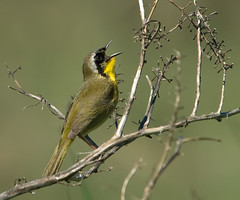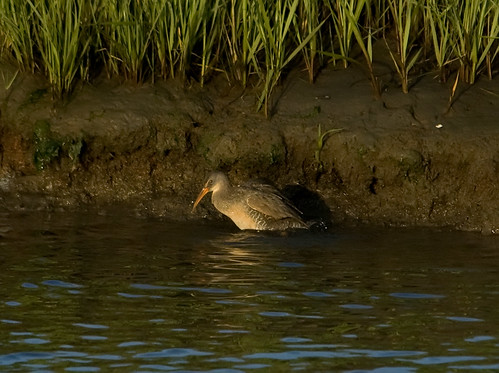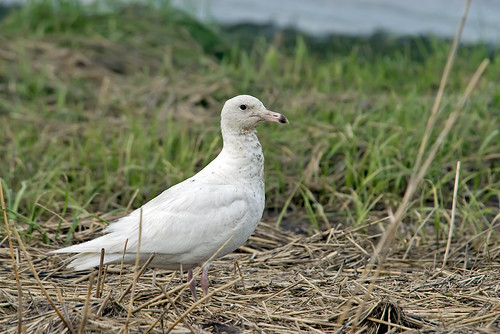A Day at Forsythe NWR
 After far too long a time, Shari and I took some time to go birding together this past weekend. We’ve both birded recently, but we haven’t done a joint birding adventure in months, so we were well past-due. And we had a great time – 12 hours of birding at Forsythe NWR in Brigantine, NJ.
After far too long a time, Shari and I took some time to go birding together this past weekend. We’ve both birded recently, but we haven’t done a joint birding adventure in months, so we were well past-due. And we had a great time – 12 hours of birding at Forsythe NWR in Brigantine, NJ.
We got there after sunrise, but still had some beautiful light to shoot by. Our first sightings were a large number of different shorebirds. It was obvious that most were either least or semi-palmated sandpipers – it turned out to be a mix of both, and Shari really got to see how to tell them apart. Mixed in were a bunch of dunlin and semi-palmated plovers, which I don’t think she’d seen that close up before. We sat there for a while getting some pictures and trying to see if there was anything rarer in the mix.
As we moved along, we came to a spot on the eastern side where a bunch of different things were hanging out. We decided to do something we rarely do at Forsythe and get out of the car and just sit on the bank. Along with the previous suspects, we were treated to a number of new arrivals – ruddy turnstones, laughing gulls and eastern willets, all looking good in their breeding plumage. We must have spent a half-hour just sitting there as the shorebirds came in and around us at close range. A clapper rail even decided to play for a bit, the first of many we would see that day.
When we finally decided to move on, we were to find that the day was going to be chock full of great birds. There are certain things that you expect at Forsythe at this time of year – herring gulls, Forster’s Terns, Great Blue Herons, Great Egrets, Snowy Egrets, Osprey – and it didn’t disappoint. But we were also treated to some species that we don’t see there very often, most of them in full breeding feathers: Whimbrel, Common Tern, Yellowlegs, Greater Black-backed gulls and Sanderlings, to name a few. But one of the most impressive things was seeing the hundreds of black-bellied plover that were manning the marsh fields toward the bay. It was quite impressive out there in their strong black-and-white colors. And there were even a few American golden plover thrown in for good measure – a relative rarity at Forsythe this time of year.
But the hits didn’t stop coming. We had a few short conversations with different folks including one pair of birders who may have seen a ruff there, but we never got a good enough look to be sure. We did, however, see another rarity at a distance – my first Curlew Sandpiper, a European bird which is a vagrant here in the eastern U.S. I didn’t know what it was when I first saw it, but I kept looking for about 10 minutes and was rewarded with a couple of clear views through the binoculars (I’m really getting back into the ‘binoc’ birding thing – I don’t get a record but I get better looks. Maybe it’s time to spring for a pair of better ones?), and was able to read off markings. When I got back in the car, I couldn’t find a match at first but The Shorebird Guide provided a picture that was a dead ringer, and gave me my ID and lifebird. As a bonus, while I was looking for that, we found the Glaucous gull everyone’s been talking about – right in front of us. Add another lifebird!
We ended up going around 4 times before the light completely failed, and saw a lot of cool stuff. Some of the other highlights:
- At least 10 different clapper rails in a total of 18 or so sightings. This is especially nice since 25 died in the nor’easter at the beginning of the month, so it’s good to see the population is still strong.
- Black Skimmers and American Oystercatchers are back – although not too many of them.
- Strangely, this might be our first visit ever where we didn’t see any Northern Harriers. Not one, and we usually see 3 – 4
- There was also a distinct paucity of butterflies and odes. With the exception of a number of black swallowtails, I think we saw a half-dozen butterflies and 3 odonata the entire day, which was a little disappointing.
- Shari’s first Blue Grosbeak. I had seen them before, and when I saw one sitting on a branch, I knew instantly what it was. Luckily, it flew into a tree nearby where we watched it ‘chhttt’ over and over and she got a nice shot. I also got a lesser shot of it – but it will be the lifelist entry (for now).
Overall, it was a great day. We haven’t done this in quite a while, and it was nice to spend the time with her and the dogs, meet some other birders (including Howard) and have a day to relax and bird. I missed some shots, I got some shots, but it was all relative — something that was nice to get back to. Of course, I want to go out again this Saturday, but we’ll see what happens…
So, here’s the official list (* = new lifebird, ^ = First of Season, # = photo lifelist)
- Semi-palmated sandpiper
- Least sandpiper
- Spotted Sandpiper
- Dunlin
- Semi-palmated plover^
- Black-bellied plover
- American Golden Plover^
- Short-billed Dowitcher
- Long-billed Dowitcher
- Red Knot^
- Greater Yellowlegs
- Lesser Yellowlegs
- Curlew Sandpiper* (imm./April plumage) (along the west drive just past the osprey nest)
- Whimbrel
- Willet
- American Oystercatcher^
- Ruddy Turnstone
- Sanderling
- Yellow Warbler
- Magnolia Warbler
- Prairie Warbler
- Black-and-white Warbler
- Common Yellowthroat #
- Willow Flycatcher
- Eastern Kingbird
- Osprey
- Red-tailed Hawk
- Peregrine Falcon^
- Forster’s Tern
- Common Tern^
- Gull-billed Tern^
- Black Skimmer
- Laughing Gull
- Greater Black-backed Gull
- Herring Gull
- Glaucous Gull (imm.)*
- Great Egret
- Snowy Egret
- Great Blue Heron
- Black-crowned Night Heron
- Glossy Ibis
- Clapper Rail^
- Virginia Rail (heard only)
- Black Duck
- Mallard
- Gadwall
- Canada Goose
- Double-crested Cormorant
- Eastern Bluebird
- Hermit Thrush
- Seaside Sparrow
- Song Sparrow
- Chipping Sparrow
- Savannah Sparrow^
- Tree Swallow
- Barn Swallow^
- Purple Martin
- Blue Grosbeak #
- Mockingbird
- Catbird
- Towhee
- Eastern Meadowlark
- Turkey Vulture
- American Robin
- Cardinal
- Goldfinch
- American Crow
- Fish Crow
- Red-winged Blackbird
- Common Grackle




whatever that ginormous white bird is… it’s cool
It’s called a great egret – about the size of a great blue heron, but all white. Here’s another shot of one (full body)
Yeah, that guy looks like the white birds I described in my blog … of course from a distance it’s hard to say, but I’m pretty sure that’s it.
It is crazy all the different birds you saw! Then again, 12 hours is a marathon birding session, wow. I’m glad you got out — I sure have been enjoying lots of outdoor time lately too.